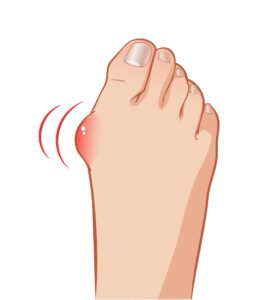European Foot and Ankle Clinic
We can help you! For your first evaluation and resolution to your concerns please visit us in our Hallandale Beach FL location. We speak English, Spanish, Polish and Russian.

Min Invasive Bunions Surgery
Minimally Invasive Surgery Treatment for Bunions and Hammertoes Deformities
Current Concepts In Minimally Invasive Bunion Surgery
Modern minimally invasive bunion surgery allows smaller incisions and facilitates easier recovery for patients.
Can bunions be corrected without surgery?
Conservative, nonsurgical treatment for bunions include wearing only wide-toed and/or soft shoes, using “bunion pads” or toe spacers, and taking nonsteroidal anti-inflammatory drugs (NSAIDs), such as ibuprofen. Toe spacers and devices to hold the big toe apart from the second toe may help with pain, but they will not make the bunion go away. The alignment of the toe will not get better over time without surgical intervention.
Who should have bunion surgery?
Bunion removal surgery should not be done for cosmetic purposes only. It is performed on patients whose daily lives are affected by pain and difficulty wearing shoes even after trying wider, more comfortable footwear.
If you have tried wearing wider shoes, padding, toe spacers or other treatments but still have pain that is limiting your activity, you may be a candidate for surgical bunion correction.
Traditionally, bunion surgery can be quite painful and involve a long recovery. However, some patients can benefit from Innovative , minimally invasive techniques that have significant advantages.
Minimally invasive bunion surgery, also referred to as percutaneous bunionectomy, is a surgical procedure to correct a bunion deformity using small surgical cuts.
During a minimally invasive bunion surgery, a few small incisions are made through the skin of the foot (percutaneously) to access the bone around the bunion, as opposed to a much larger incision made during an open bunion surgery that cuts across layers of tissue around the bone, causing more postoperative pain, a larger scar, and damage to the surrounding soft tissues.
The main objectives of minimally invasive bunion surgery are to realign the joint, correct the deformity, and relieve pain and discomfort with minimal complications.
Minimally invasive bunion surgery offers several advantages over traditional bunionectomy. Modern advances in minimally invasive bunion surgery techniques and technology have allowed for tiny incisions, an instant walking recovery, much less postoperative pain, shorter operative time and an overall easier recovery as no tourniquet is needed , no damage to fragile blood vessels , happier patient!
The main advantage of minimally invasive bunion surgery is the ability to perform a bunion correction with minimal disruption or trauma to the overlying skin and soft tissue.
The term “minimally invasive bunion surgery” is an extremely vague term that can encompass a variety of bunion correction methods and incisional approaches.
Minimally invasive bunion surgery is loosely defined as a “bunion correction” using very small or tiny incisions (percutaneous incisions) rather than typical large incision(s) with traditional open methods. Minimally invasive incisions usually range from 1/8⅛ inch to ½ inch whereas traditional bunion surgery incisions range from 2 inches to 6 inches.

What are the benefits of minimally invasive versus traditional bunion surgery?
Minimally invasive bunionectomy involves less pain, a faster recovery, and better cosmetic results due to the small incisions. Open surgery, however, is used if implant placement in the distracted joint is necessary, it’s a more powerful correction for very severe bunion deformities.
European Foot and Ankle Clinic is one of the pioneers in performing MIS techniques in successful correcting foot deformities. This advanced technique is utilized here by Dr Goshko and Dr Podolskiy since 2013.
Recovery from minimally invasive bunion surgery
After MIS bunion or hummer-toe surgery, you will be fitted with a special surgical post-op shoe, and you can bear full weight almost immediately, after full feeling in your foot has been restored. For the first two weeks after surgery, you will need to limit your activity and keep your foot elevated when at rest to decrease the swelling and allow the wounds to heal.
After the first two weeks, you may be given a bunion splint to maintain the postsurgical alignment. During this time, you can gradually increase your walking and resume normal activities of daily living.
How successful are bunion operations and what are the risks?
The majority of patients are very happy with their bunion operation. Assuming the patient follows the postoperative instructions carefully, the outcomes are very good. There are risks of bunion surgery, however. Delayed bone healing can occur with any foot surgery, but this is rare. This risk is increased if patients do too much too soon (against the doctor’s advice) and/or they have health issues that can affect bone healing. Some numbness around the incisions may be noted after the procedure. This typically goes away in three to six months. In rare cases it can persist. Bleeding, blot clots, and risks associated with anesthesia are also rare complications. Recurrence of the bunion (the bunion coming back) can occur after any type of correction, and this risk is not known to be increased in those who have the minimally invasive bunion correction surgery.
Please see our Before and After pictures


